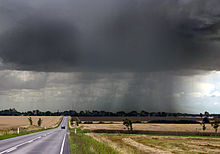Warming up to the idea of more extreme weather in Australia

Parts of Australia may experience an almost doubling of the 1 in 100-year rainfall intensity by the end of the century. In recent research led by Dr Conrad Wasko of the University of New South Wales, it was found that by simulating what rainfall might look like for the future climates of Sydney and Brisbane, the one hour 1 in 100-year Average Recurrence Interval (ARI) rainfall increased at rates approximately equal to 18% / ºC.
There are a range of changes expected to both mean and extreme rainfall in the future and any list is unlikely to be exhaustive. Broadly, an intensification of storms is expected resulting in greater storm volumes, with precipitation more concentrated in time and space. The frequency and type of storm events is also expected to change, bringing greater downpours more often.
“Australian Rainfall and Runoff provides conditioning on temperature rise as one of the recommended approaches for considering climate change in flood studies. However, this approach only captures changes in design rainfall, whereas it is increasingly recognised that changes in flooding in the future will not just be a function of changes in the design rainfall but also a function of changes in precipitation patterns, antecedent conditions, and catchment dynamics.” Said Dr Wasko.
In this work, the authors propose conditioning continuous rainfall records on temperature to simulate rainfall for a future climate. By conditioning the parameters used in generating rainfall sequences on historical temperature sensitives, the researchers were able to capture the wide gamut of expected changes in precipitation as well as changes in antecedent conditions.
The authors found that they were able validate their methodology and capture the historical variability in precipitation over a wide range of statistics.
“This suggests that, as with similar work in the field, historical relationships with temperature are a good indicator of how precipitation patterns are likely to change in the future and the relationships derived aggregate over a large range of climate dynamics.” Said Dr Wasko.
By using only one conditioning variable, this methodology gives the user flexibility to generate rainfall records for their local conditions. If the relationship found here were to hold, under the RCP8.5 emission scenario we could expect almost doubling of the 1 in 100-year rainfall intensity by the end of the century.
Article: ‘Continuous rainfall generation for a warmer climate using observed temperature sensitivities’, Wasko, S., and Sharma, A., Journal of Hydrology, doi.org/10.1016/j.jhydrol.2016.12.002
